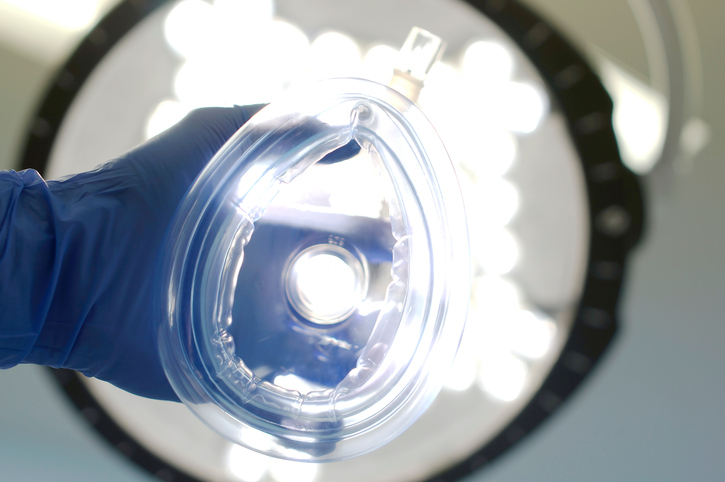Results of a recently released survey of healthcare workers who provide anesthesia care show that many are not following recommended practices when administering anesthetics. Healthcare employers should review the survey and buck up their safety programs where they think training for their employees who administer anesthetics is lacking.
 |
Today we will take a look at the results of the survey and the possible health effects of exposure to anesthetic gases. Tomorrow we will review recommendations for both employers and healthcare workers to prevent exposure to these gases.
The anesthetic gases and vapors that leak into the surrounding room during medical procedures are considered waste anesthetic gases, According to the Occupational Safety and Health Administration (OSHA), more than 250,000 healthcare professionals who work in hospitals, operating rooms, dental offices, and veterinary clinics, are potentially exposed to waste anesthetic gases and are at risk of occupational illness. The waste anesthetic gases and vapors of concern are nitrous oxide and halogenated agents (vapors) such as sevoflurane, halothane, enflurane, isoflurane, and desflurane. In a recent article reporting on a survey of over 3,000 anesthesia care providers, the National Institute for Occupational Safety and Health (NIOSH) found that scavenging systems, i.e., equipment used to prevent waste anesthetic gases from escaping into the operating room, are widely used but other recommended practices to minimize exposure are not always followed.
Survey Results
The NIOSH Health and Safety Practices Survey of Healthcare Workers, which was conducted in 2011, is the largest federally-sponsored survey of healthcare workers in the United States that addresses safety and health practices relative to use of hazardous chemicals. According to NIOSH, it is the first to examine self-reported use of scavenging systems and other controls to minimize exposure to waste anesthetic gases among anesthesia care providers.
Respondents reported that the use of anesthesia machines equipped with scavenging systems was nearly universal. However, adherence to other recommended practices were lacking by varying degrees.
Here are some examples from the survey that NIOSH contends may increase risk to healthcare workers:
- 3% of the respondents did not always use anesthesia machines equipped with a waste gas scavenging system;
- 35% started anesthetic gas flow before a mask was applied to pediatric patients and 14% did the same for adult patients;
- 19% reported safe handling procedures were unavailable;
- 18% never received training on safe handling of anesthetic gases;
- 17% used a funnel-fill (open-air) system instead of a key-filler or other closed system to fill anesthesia vaporizers;
- 17% used high (fresh gas) flow anesthesia only for pediatric patients, and 6% did the same for adult patients; and
- 5% did not routinely check anesthesia equipment for leaks.
Effects of Exposure to Anesthetic Gases
According to NIOSH, effects of exposure to high concentrations of waste anesthetic gases—even for a short time—may cause:
- Headache;
- Irritability;
- Fatigue;
- Nausea;
- Drowsiness;
- Difficulties with judgment and coordination; and
- Liver and kidney disease.
Some studies report no adverse health effects from long-term exposure to low concentrations of waste anesthetic gases. However, according to NIOSH, several studies have linked such exposure to miscarriages, genetic damage, and cancer among operating-room workers. Studies have also reported miscarriages in the spouses of exposed workers and birth defects in their offspring.
How Are Workers Exposed?
Workers are most likely to be exposed to waste anesthetic gases in:
- Operating facilities with no automatic ventilation or scavenging systems;
- Operating facilities where these systems are in poor condition; or
- Recovery rooms where gases exhaled by recovering patients are not properly vented or scavenged.
According to NIOSH, even when scavenging and venting systems are in place, workers may be exposed to these gases:
- When leaks occur in the anesthetic breathing circuit (which may leak gas if the connectors, tubing, and valves are not maintained and tightly connected);
- When anesthetic gases escape during hookup and disconnection of the system;
- When anesthetic gas seeps over the lip of the patient’s mask or from endotracheal coupling (particularly if the mask is poorly fitted—for example, during pediatric anesthesia);
- During dental operations; or
- During the induction of anesthesia.
Check tomorrow’s Advisor for some recommendations for both employers and healthcare workers to prevent exposure to anesthetic gases.

Each healthcare worker should contact OSHA and complain.